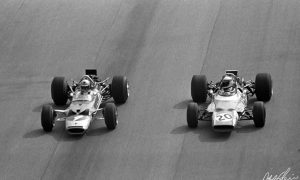
©XPB Images
TO SILVERSTONE AND BACK
Andrew Green’s career has been closely linked with his current team, which has always been based at Silverstone, regardless of the monikers it has been racing under.
In 1990, the technical department of the nascent Jordan team included three people: Gary Anderson was running the show with the assistance of two engineers he had met at Reynard in F3000: Green, who had just graduated from the University of Portsmouth with a degree in mechanical engineering, was entrusted with the suspension, while Mark Smith would work on the transmission.
On weekends, Anderson and Green conducted aero tests on the future 191 in the University of Southampton's windtunnel, using a van to bring the prototype on site. The pair worked wonders with scarce resources. Nimble and offering good driveability, the first Jordan F1 car would spring a few surprises during the team’s debut season.
“At the end of the day, on Sunday afternoon, there are only two teams that are happy: one is the team that has won, and the other one is the team that is ahead of where it should have been.”
Green stayed at the design office until 1995 when Anderson made him part of the trackside operations as Eddie Irvine’s race engineer. He then worked alongside Rubens Barrichello and Ralf Schumacher before accepting Adrian Reynard’s offer to join the new BAR team.
As head of mechanical design, Green assisted technical director Malcolm Oaster, until Dave Richards started cleaning house and took over the team in 2002. Having moved over to Jaguar Racing, he worked as a consultant there for a couple years and was hired in 2005 by new owners Red Bull Technologies to oversee their Research and Development department. Green added simulation and modelling tools to Milton Keynes all the while working on vehicle dynamics.
He returned to a consulting role in 2008 before coming back to Silverstone two years later to work for Force India, the latest guise of the Jordan team after the short-lived Midland and Spyker experiences. In 2011, Green came full circle in succeeding his former colleague Mark Smith as technical director.

©XPB Images & Wri2
THE JOY OF THE OUTSIDER
After benefitting from abundant resources at a fast-growing Red Bull team, Green once again had to make do with limited financial means, although the team had been expanding since he had started there to match F1’s unabated march towards professionalisation. In order to cope with the sport’s ever-increasing budgets and faster development pace, Force India had to make clever choices, the sort of decisions that would pave the way for the Haas F1 Team to join grand prix racing in 2016 for instance.
Instead of manufacturing its own gearbox, Force India has been buying the component from another team (McLaren in 2009-2014, Mercedes since then). That way, it can devote its resources to more efficient levers of performance such as the aerodynamics, the suspension, etc. Racing in the midfield forces a team to be smarter than its better-funded rivals and would even present some advantages, according to Green.
“We are a budget-limited team: we have to spend our money very wisely. When someone presents me something that is a performance improvement to the car, I have to work on how much it costs to get it to the track. I have to see whether we can afford it or not, or whether it’s better to wait for a bigger step. It’s juggling performance and financial – or human – resources.
“Big teams try several options, and then pick the good one. We can’t do that. We have to be sure we choose the right one. But it’s a challenge that we love. When we beat the big teams, it’s good fun, we enjoy doing it.
“At the end of the day, on Sunday afternoon, there are only two teams that are happy: one is the team that has won, and the other one is the team that is ahead of where it should have been. We like to think we can beat people we shouldn’t really beat. That’s our culture.
“We know we can be smarter than the big teams, because being small gives you that flexibility and the speed of development which the big teams don’t have. They are like oil tankers in that it takes them a long time to make a change of direction, whereas we can go from being in front of a screen to saying, ‘great idea, bang, let’s get a drawing out, let’s get some of it made.’ Next morning, it’s on your desk and you can try it.
“We try and get an advantage by being more reactive. Because my team is small, I can interact with almost anyone of them. I’m not tied to managing large groups of people or sitting in lots of meetings.”

©XPB Images






